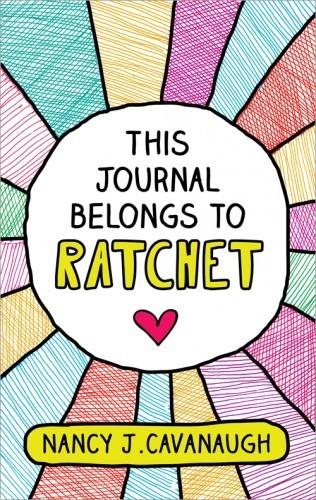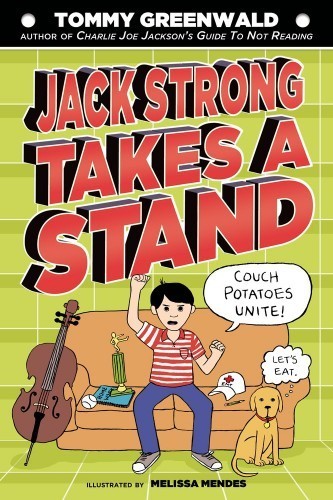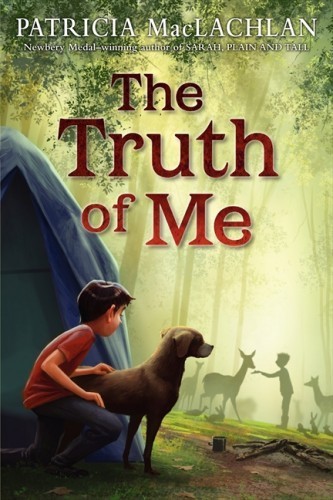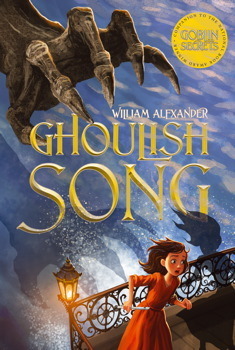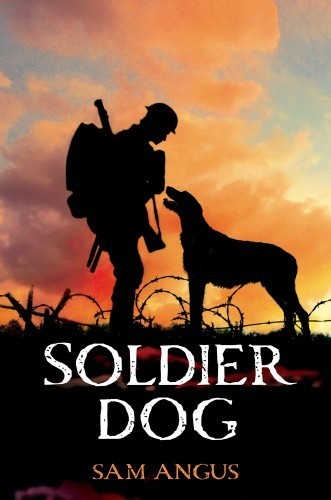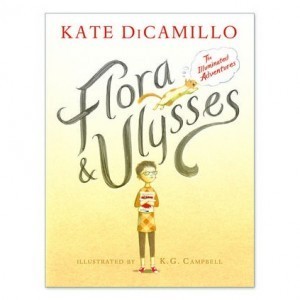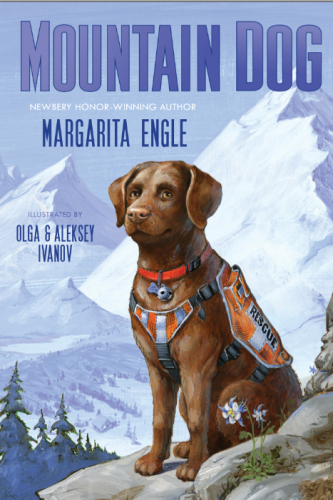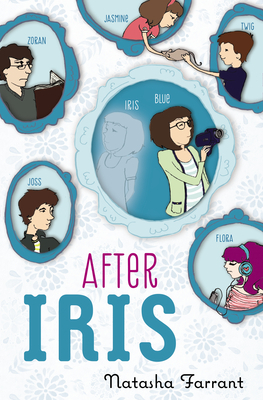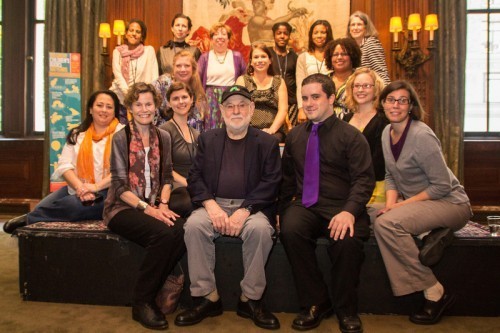Betsy Bird's Blog, page 303
October 9, 2013
Review of the Day: Knock Knock by Daniel Beaty
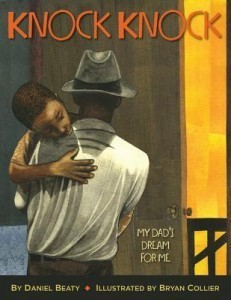 Knock Knock: My Dad’s Dream for Me
Knock Knock: My Dad’s Dream for Me
By Daniel Beaty
Illustrated by Bryan Collier
Little, Brown Books for Young Readers
$18.00
ISBN: 978-0316209175
Ages 4-8
On shelves December 17th
There is a perception out there amongst certain types of parents that the only picture books worthy of their little geniuses are those that reflect their own lives perfectly. I’ve complained more than once about this before, but there is nothing more disturbing to me than when a children’s librarian shows a parent a perfectly lovely book only to be asked, “Do you have anything a little less . . . urban?” And this in the heart of New York City no less. Of course we all know what “urban” is code for. Black, obviously (if I’m feeling snarky I’ll then follow up their request with Precious and the Boo Hag or something equally black AND rural). The ideal use of picture books, on some level, is to provide windows and mirrors for the kiddos. Mirrors that reflect their own worlds. Windows where they can see how other children live. So while Daniel Beaty’s Knock Knock: My Dad’s Dream for Me is ostensibly about a child with an incarcerated father, to my mind this is a book that has far reaching applications. It can be used with any child missing a parent, for whatever reason. It’s one of the very few picture books to talk about the process of growing into adulthood. And the art? Stellar stuff. So though I’m sure kids that find themselves exactly in the protagonist’s shoes will get something out of this book, they are not the only ones. Not by half.
It was the same every morning. The boy would pretend to be sleeping when his father went “Knock Knock” on the door. Then he’d “surprise” his father by leaping into his arms once he came in the room. That is, until the day his father didn’t knock anymore. The man is simply gone, poof! Like he was never there at all. Bewildered and lost, the boy writes his father a letter and leaves it on his desk in the desperate hope that maybe his dad’s in the apartment when the boy’s not home. He tells his dad that he was hoping that when he got older he’d teach him how to dribble a ball or shave or drive or fix a car even. Then, one day, there’s a letter from his father sitting on the desk. “I am sorry I will not be coming home,” it begins. It then proceeds to encourage the boy to seek his own path and grow to manhood without him. “Knock Knock with the knowledge that you are my son and you have a bright, beautiful future.” Years later when the boy has grown, his father returns to him. In his Author’s Note, Daniel Beaty discusses the effect his own father’s incarceration had on him when he was only three. As he puts it, “This experience prompted me to tell the story of this loss from a child’s perspective and also to offer hope that every fatherless child can still create the most beautiful life possible.”
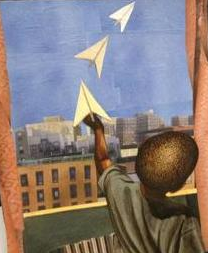 As you might imagine, I vetted this one with some of my fellow children’s librarians and one concern that arose stemmed from the fact that the boy isn’t told what happened to his father. One day he’s there and the next he’s gone. Shouldn’t a kid be told? To this I have a couple answers. First and foremost, remember that you are getting this tale through the eyes of a child. For that very reason, you have reason to question the narrative. It is all too easy to believe that the kid has been told where his father is and he simply cannot process the information. This might be one of those rare picture book unreliable narrators we come across from time to time. Second, if the kid isn’t willfully ignoring the evidence at hand, it’s just as possible that his mother isn’t telling him. Whether it’s for what she believes to be his own good or because she can’t bring herself to explain, there’s a reality at work here.
As you might imagine, I vetted this one with some of my fellow children’s librarians and one concern that arose stemmed from the fact that the boy isn’t told what happened to his father. One day he’s there and the next he’s gone. Shouldn’t a kid be told? To this I have a couple answers. First and foremost, remember that you are getting this tale through the eyes of a child. For that very reason, you have reason to question the narrative. It is all too easy to believe that the kid has been told where his father is and he simply cannot process the information. This might be one of those rare picture book unreliable narrators we come across from time to time. Second, if the kid isn’t willfully ignoring the evidence at hand, it’s just as possible that his mother isn’t telling him. Whether it’s for what she believes to be his own good or because she can’t bring herself to explain, there’s a reality at work here.
But the explanation that rings truest to me is this; If the boy doesn’t know then it opens wide the possible applications of this book. The key to Knock Knock lies in the fact that Beaty’s tale is about an absent parent and not necessarily an incarcerated one. Lots of kids have one parent or another disappear on them. What Knock Knock is telling us is that even if they’re not there, you can grow up and become the man or woman you were meant to be. Now, obviously the book is primarily about incarcerated parents. The ending shows the boy, now grown into a man, hugging his father for the first time in years. Unless we’re going full on metaphorical here, that image is pretty clear. Nonetheless, I like to think that the book has a broader appeal than that. It’s not as if the word “jail” or “arrested” are ever in the text, and the images never follow the father but keep the focus squarely on the kid. As is right.
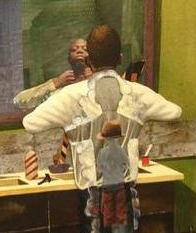 The art is the real kicker, of course. Not since Uptown has Collier lavished this much time and attention on the appearance and feel of Harlem. I should know. I live in it. From the Duke Ellington statue on the corner of 5th Avenue and 110th Street to brownstones and housing projects, Collier knows of which he speaks. Then there’s how he chose to bring Beaty’s words to life. According to Collier, he took a real interest in this text when he saw Beaty perform it in a monologue. In this book he then tries to capture the spirit of the performance. For example, he explains in his Illustrator’s Note at the end of the book that the watercolor and collage art affects the boy’s surroundings. “The sky in the art is not so blue”, a fact I’d completely missed. It’s true, though. You wouldn’t necessarily notice at first, but the dulled blue contrasts sharply with the vivid aquamarine on the last page.
The art is the real kicker, of course. Not since Uptown has Collier lavished this much time and attention on the appearance and feel of Harlem. I should know. I live in it. From the Duke Ellington statue on the corner of 5th Avenue and 110th Street to brownstones and housing projects, Collier knows of which he speaks. Then there’s how he chose to bring Beaty’s words to life. According to Collier, he took a real interest in this text when he saw Beaty perform it in a monologue. In this book he then tries to capture the spirit of the performance. For example, he explains in his Illustrator’s Note at the end of the book that the watercolor and collage art affects the boy’s surroundings. “The sky in the art is not so blue”, a fact I’d completely missed. It’s true, though. You wouldn’t necessarily notice at first, but the dulled blue contrasts sharply with the vivid aquamarine on the last page.
To my mind, the eeriest image in the book is a two-page spread that shows the boy seemingly flying on the paper airplane message he’s trying to send to his dad. As his father’s oversized hat flies from his head you see below the fading faces of other children on the tarred roofs below. Their images are sometimes clear, sometimes eerily faint, like they’re memories being erased by time. There are also a fair number of elephants. The elephants are an interesting touch. I’m not entirely certain what to make of them. They trundle along the boy’s bedroom walls, then occasionally break free and appear in his memories, walking across the brownstones, partially obscuring a man’s face hidden behind the windows.
Impressive though the art may be, there are moments in the book that seemed better than others. Faces and features vary, sometimes striking the reader as affecting while at other times they take you out of the book entirely. The aforementioned shot of the boy flying in a paper airplane while his father’s hat drifts towards the faces of other children on the roofs below is a bit unnerving if only because the roof faces are so much more affecting than the boy himself. When done straight on, as on the page that reads, “I am sorry I will not be coming home” the results are much stronger. And that’s even before you notice that the boy has draped his father’s ties around his neck (and did you notice that as a man the boy continues to wear those ties?).
Here’s what might be my favorite line in the book: “Papa, come home, ‘cause I want to be just like you, but I’m forgetting who you are.” Kids everywhere grow up without fathers and a single book isn’t going to necessarily change their lives. But maybe, just maybe, it really will touch somebody in the right way. When Bryan Collier writes in his Note that “This book is not just about loss, but about hope, making healthy choices, and not letting our past define our future,” he’s talking to kids everywhere that are dealing with a deck that’s stacked against them. They don’t get enough books, those kids, about lives like their own. Fortunately, once in a great while, a book comes along that fulfills that gaping need. This year, it’s this book. Next year? Who knows? But as long as there are children struggling along without their parents, Knock Knock is going to have a job to do.
On shelves December 17th.
Source: Final copy sent from publisher for review.
List This? Then Try:
Visiting Day by Jacqueline Woodson
When Dad Was Away by Liz Weir
A Visit to the Big House by Oliver Butterworth
Interviews: Collier talks a bit about his work on this book with SLJ. Turns out he was the one who had the idea of turning Beaty’s poem into a book!
Videos:
Want to see Beaty perform it for yourself? Then it’s your lucky day:
October 8, 2013
Press Release Fun – The ABC of It: Curator Leonard S. Marcus in Conversation
If you have visited NYC in the last few months and failed to take a gander at the children’s literature exhibit currently going on in the main branch, this is a bad thing. Fortunately, we’re going to bring the exhibit to you, in a sense. A Google Hangout is being planned for this Saturday’s Literary Salon. So even if you can’t make it yourself you’ll be able to see our esteemed curator talk about it. The link for the Hangout will be: https://plus.google.com/events/cd7difagbpt2makm7jhqbbhq734
NYPL’s Children’s Literary Salon is pleased to announce our event on Saturday, October 12th at 2:00 p.m.
The ABC of It: Curator Leonard S. Marcus in ConversationJoin Bank Street’s Center for Children’s Literature, Interim Director Jenny Brown as she interviews historian and critic Leonard S. Marcus about his current NYPL exhibit and the importance of children’s literature as a whole.
This event will be held in the South Court Auditorium in the main branch of New York Public Library (42nd Street & 5th Avenue – big stone lions out front).
October 7, 2013
And Now . . . Introducing the WORST Parents of 2013!
Read enough middle grade children’s literature and it all begins to blend. In 2013 I’ve noticed the occasional odd trend here and there, but when it comes to a post like this one I fall back on an old reliable: Terrible parental units. They’re staples. They’re what keep us going. Admittedly they’re far more common in young adult literature than children’s literature (the general tone in children’s books is just the kill them off early) but once in a while you get a real baddie. What does this say about the role of parents in books for children? Indeed, what does it mean for a story when the greatest protagonist is often one’s own parent? From the depressing to the deplorable, sometimes I like to catalog the worst of the worst and assess what it might mean about parents in books for kids at all.
To limit myself I’m only going to include actual parents, not step-parents or aunts and uncles (sorry, The Boy Who Swam With Piranhas). Here then are some of the parents that made me want to reach within the pages of the books with intent to strangle. We put them into three categories. The first, and widest, is:
Mildly Awful
A Girl Called Problem by Katie Quirk
On the one hand, Shida’s mother is biting, neglectful, and self-absorbed. On the other, it seems pretty clear, to the average adult reader anyway, that she’s clinically depressed. The mother in Hold Fast by Blue Balliett falls into the same category. This is a mom who can’t help herself, let alone her kid.
This Journal Belongs to Ratchet by Nancy J. Cavanaugh
The dad in this particular book falls into the category of Dads-who-care-more-about-a-cause-than-their-own-kid. Indeed the flaw of the book isn’t the writing or characters, which are entirely charming, but rather the fact that the dad isn’t punished for his abject neglect of his kid by the tale’s end. Grrrr!
Jack Strong Takes a Stand by Tommy Greenwald
Again with the bad dad. Not a villain by any stretch, but any father who refuses to let their kid lighten up their after school load when that kiddo hardly has time to eat or sleep is no saint. The mom isn’t much better with her aversion to conflict, but she improves. And so, to be fair, in time does the dad.
The Truth of Me by Patricia MacLachlan
The dad is essentially useless, both as a character and a parent. And the mom? If you’re not talking about her music she can’t relate to you. These two fall squarely into the category of Folks Who Shouldn’t Have Had a Kid In the First Place.
The next category is . . .
Pretty Darn Bad
Africa is My Home: A Child of the Amistad by Monica Edinger
Technically it’s fiction. In this book I’m thinking particularly of Magulu’s father, who is directly responsible for her ending up a slave. Admittedly it was an extreme circumstance and he didn’t feel great about it. Still and all, ending up in the slave trade is NOT a good thing to inherit from your papa.
Ghoulish Song by William Alexander
We know they have their reasons. Sure they do. But acting like your kiddo is dead just because she misplaced her shadow? Geez, dudes. Nothing right about that one.
Soldier Dog by Sam Angus
Without giving anything away, when Stanley’s father does the unspeakable act that causes his son to run away from home to join the WWI front, you’re totally on Stanley’s side. Here we have a grief-stricken father, which explains his actions to some degree, but for at least half the book you aren’t seeing that. You’re just seeing his flaws. And they’re enormous.
Flora & Ulysses by Kate DiCamillo
The sin suggested in the Sam Angus book is mirrored in this one. When your mom is hellbent on killing your pet, that’s when you have to figure she’s got some problems of her own. And Mrs. Buckman hasn’t much in the way of redeemable qualities. I might even come close to putting her in the category of . . .
Bad As They Get
Mountain Dog by Margarita Engle
When your mom is arrested for participating in an illegal dog fighting ring, that’s bad. But disappointing your offspring continually after that? Let’s give this mom a hand. She’s pretty terrible.
And the winner, of WORST parents of 2013 are . . .
After Iris by Natasha Farrant
Admittedly it’s hard to compete with selling your kids into slavery or going to jail for illegal activity, but the Gadsbys have their own unique flaws.
Now bear in mind that when I say this I do so knowing full well that Mr. and Mrs. Gadsby do not beat or hit or really even yell at their kids. Instead, they abandon them with a frequency that made even the smallest hairs on the back of my neck stand on end. These self-absorbed, greedy, tunnel vision parents have their reasons for acting the way they do. Well . . . Mrs. Gadsby thinks she does anyway. Having lost a child three years earlier she stays away from her family because it’s too hard to cope. Well boo-hoo to you, madam. When even your rebellious teenage daughter is desperate for your presence, you know you’re doing something wrong. Mr. Gadsby, in sharp contrast, is a cad. His seeming turnaround at the end of the book did not fool me one bit. He’s a horror show of a parent. The Gadsby children are better off without him. There. I said it.
Now you let off some steam. Worst parents in children’s novels of 2013 . . . GO!
October 4, 2013
Fusenews: I had a little list, the prettiest ever seen
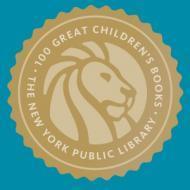 Oh, so very much has gone on this week! Where to begin? What to do? Well, for starters, NYPL released a handy dandy list to accompany their current exhibit The ABC of It: Why Children’s Books Matter. I helped make said list, which is officially called 100 Great Children’s Books, 100 Years. So, two things. #1: We didn’t say “best” or “most popular”. We just said great. These are great books. Hard to argue with that. And #2: It’s just the stuff published in the last 100 years. So before you get your knickers in a twist, there is a reason The Secret Garden, The Wonderful Wizard of Oz, and Alice’s Adventures in Wonderland are nowhere in sight. NYPL even lets you buy the books in little packages by age level or the whole kerschmozzle at one time. Groovy.
Oh, so very much has gone on this week! Where to begin? What to do? Well, for starters, NYPL released a handy dandy list to accompany their current exhibit The ABC of It: Why Children’s Books Matter. I helped make said list, which is officially called 100 Great Children’s Books, 100 Years. So, two things. #1: We didn’t say “best” or “most popular”. We just said great. These are great books. Hard to argue with that. And #2: It’s just the stuff published in the last 100 years. So before you get your knickers in a twist, there is a reason The Secret Garden, The Wonderful Wizard of Oz, and Alice’s Adventures in Wonderland are nowhere in sight. NYPL even lets you buy the books in little packages by age level or the whole kerschmozzle at one time. Groovy.In conjunction with the exhibit and the list, the library brought over Judy Blume and Eric Carle. So, naturally, when a photograph was to be taken I wedged myself between the two of them. I intend to blow it up, crop it, and then in fifty years claim to my grandchildren that we were all bestest buddies and this was taken mere moments before we stepped out for some pie.
And now, on the depressing side of things, Gary Soto explains why I haven’t seen a new children’s title come out of him since I got my library degree. I just completely missed that entire Marisol debacle. In 2005 I was a newly minted librarian. Seems a bit unfair that I just missed the output of Soto. So come on, man! That was basically a decade ago. Time to do with the typey type.
In happier news, Vermont college offers a scholarship to minority children’s & YA authors. This fact is accompanied by a killer photo of Angela Johnson. Worth it right there.
More with the me stuff. Rob Smith was kind enough to interview me for his podcast The Interactive Teacher. Now the podcast is up and running and you can hear me yammer from here to Sunday, should you chose to do so. If you follow this link you’ll find that the written recap isn’t strictly what I’ve said, but it comes close. Thanks for chatting with me, Rob! Good stuff.
I don’t care that it’s YA. I think I’m still going to have to read this when galleys become available. If only because the last name of the heroine is Gumm. Cute.
I know Banned Books Week is over but I just wanna say one thing. Anything that uses rollergirls can only be a force for good. In my next life, I’m coming back as one of them. I ain’t kidding.
Note to Self: Create place on website where you can include amazing examples of programs that folks have done in conjunction with Giant Dance Party. Today’s example, Ms. Helen N. Hill and the AMAZING ideas she came up with after reading my book. This completely and utterly rocks. Thank you, Helen!!!
Speaking of GDP, do you happen to live in NJ? Anywhere near Montclair? Wanna see me dance like a fool and read my book? Watchung Booksellers is hosting l’il ole me this coming Saturday morning at 10:30. Please come!
Do you instead live on the other side of the country entirely? Say, around the San Francisco area? Then why don’t you consider heading on over to Booksmith on Saturday, October 20th at 2 p.m.? Apparently Julie Downing ( Spooky Friends ) and Lisa Brown ( Vampire Boy’s Good Night ) will come together to tell Halloween stories and draw pictures of the kids that attend in costume. Now there’s an offer you can’t refuse.
Daily Image:
Haven’t a clue where my Aunt Judy found this or even who it’s by. All I know is I love it.
I want to go to there.
October 3, 2013
Review of the Day: Rotten Pumpkin by David M. Schwartz
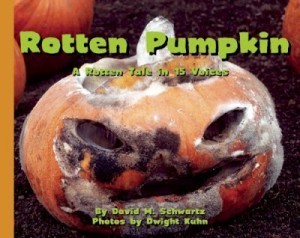 Rotten Pumpkin
Rotten Pumpkin
By David M. Schwartz
Photos by Dwight Kuhn
Creston Books
$16.99
ISNB: 978-1-939547-03-3
Ages 4-8
On shelves now.
Every October you walk into your bookstores and your libraries and you see the overwhelming swath of seasonal fare pelt you from every side. Apples and pumpkins, scarecrows and black cats. You begin to wonder if it’s possible to do anything that’s both new and autumnal anymore. Then you turn around and you see the book most likely to make you back away in true, abject fear. Rotten Pumpkin: A Rotten Tale in 15 Voices is basically what you’d get if you took Paul Fleischman’s Joyful Noise: Poems for Two Voices or Laura Amy Schlitz’s Good Masters! Sweet Ladies!: Voices from a Medieval Village and turned those bugs and people into molds, slugs, and other creepy crawlies. I have never been so overwhelmed with a desire to wash my hands after reading a book as I have reading Schwartz’s latest. That’s a compliment, by the way.
It doesn’t start off all that badly. On Halloween night a triumphant little pumpkin merrily grins at the reader. “Here I stand, bright with light, proud and round. Tonight is my glory night. Call me Jack.” Its hubris doesn’t last long. The first unwelcome visitor is a chomping chewing mouse. The next a squirrel. Then come the slugs, a fly, and most dramatically the black rot. Once the rot’s set in it’s just a question of how quickly Jack will disintegrate. Schwartz fills his story with plenty of useful information, like the fact that low temperatures don’t slow most of the fungi that eat pumpkins. Or the strange nature of the plasmodium and its odd ways. By the end we see how life begins anew, thanks in large part to the creatures that help with decomposition. A glossary of terms and useful “Classroom Investigations” are found at the end of the book.
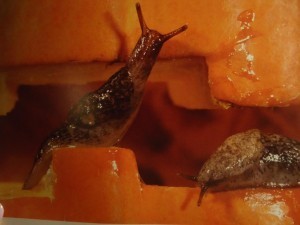 When we think of books told in a variety of different voices, our minds instantly think of some of the loftier titles for kids out there. Award winners. Collections of monologues. That sort of thing. So I think it would be particularly refreshing for kids to embody the characters in this book. I’m suddenly envisioning the world’s grossest school play, wherein our hero, the pumpkin, is eaten and devoured by his/her classmates, piece by piece. The characters, if you can call them that, aren’t delineated in the text by anything more than their images. Sections run together without chapter titles. I was also a bit sad that the photos were separate from the text, when it would have been nice to see the two integrated. That said, I did like the writing. It does a good job of telling a story, conveying some really interesting factual information, and grossing you out. Surprisingly, this is the book that actually explained Penicillium to me better than anything else I’ve ever read. Not being much of a scientist I confess that I’d always been a bit fuzzy (no pun intended) on what precisely it is that Penicillium does. I know the story of how it was discovered, but not why it works. Now I do.
When we think of books told in a variety of different voices, our minds instantly think of some of the loftier titles for kids out there. Award winners. Collections of monologues. That sort of thing. So I think it would be particularly refreshing for kids to embody the characters in this book. I’m suddenly envisioning the world’s grossest school play, wherein our hero, the pumpkin, is eaten and devoured by his/her classmates, piece by piece. The characters, if you can call them that, aren’t delineated in the text by anything more than their images. Sections run together without chapter titles. I was also a bit sad that the photos were separate from the text, when it would have been nice to see the two integrated. That said, I did like the writing. It does a good job of telling a story, conveying some really interesting factual information, and grossing you out. Surprisingly, this is the book that actually explained Penicillium to me better than anything else I’ve ever read. Not being much of a scientist I confess that I’d always been a bit fuzzy (no pun intended) on what precisely it is that Penicillium does. I know the story of how it was discovered, but not why it works. Now I do.
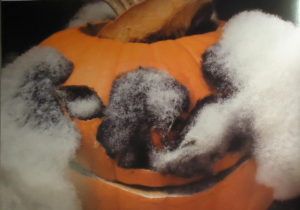 It’s hard for me to pinpoint what the most disgusting moment of this book really is. Was it the title page with its leering jack-o-lantern leering, bedecked with a black mustache of pure mold? Was it instead the yeast swimming in the fermenting pumpkin, an almost peach colored jelly packed with white rods? No. For me, without a doubt, the honor lies squarely on the spores. We have photographer Dwight Kuhn to thank for that. Having worked on “more than 140 children’s books on nature and biology”, Kuhn had his work cut out for him when it came to some of the shots in this book. The squirrel was keen, the mouse divine, and the slugs sluggy, but the shot that impressed me the most was the extreme close-up of the fly. *shudder* You’d have to see it for yourself to understand why.
It’s hard for me to pinpoint what the most disgusting moment of this book really is. Was it the title page with its leering jack-o-lantern leering, bedecked with a black mustache of pure mold? Was it instead the yeast swimming in the fermenting pumpkin, an almost peach colored jelly packed with white rods? No. For me, without a doubt, the honor lies squarely on the spores. We have photographer Dwight Kuhn to thank for that. Having worked on “more than 140 children’s books on nature and biology”, Kuhn had his work cut out for him when it came to some of the shots in this book. The squirrel was keen, the mouse divine, and the slugs sluggy, but the shot that impressed me the most was the extreme close-up of the fly. *shudder* You’d have to see it for yourself to understand why.
Who says the scariest Halloween books for kids are strictly fictional? With Rotten Pumpkin you’ve all the thrills of a typical horror story, laden with facts along the way. The hero at the top of his game. The downfall. The insidious, frankly disgusting, forces that eat away at him until he’s nothing left but a blackened husk of his former self. Oh, it’s thrilling stuff. With applications in the classroom, in the home, and on the stage, there’s nowhere this rotting corpse of a pumpkin doesn’t belong. So this holiday season don’t bother handing the kids yet another copy of Scary Stories to Tell In the Dark when they beg you for child-friendly horror fare. Just load them down with a little Rotten Pumpkin. Guaranteed to make hypochondriacs out of even the stiffest souls.
On shelves now.
Source: Final copy sent from publisher for review.
Like This? Then Try:
A Little Book of Slime by Clint Twist
The Dirt on Dirt by Paulette Bourgeois
Pumpkin Shivaree by Rick Agran, illustrated by Sara Anderson
Other Blog Reviews:
Mrs. ReaderPants
The Armchair Librarian
Second Bookshelf on the Right
Cozy Little Book Journal
Kid Lit Frenzy
Novel Nutritious
Professional Reviews:
A star from Kirkus
Publishers Weekly
Interview: David M. Schwartz answers his own questions about the book.
October 2, 2013
Ask a Librarian: Find the Right Book for Your Child
So the good folks at Noodle had a proposition for me. Noodle, for the record, is this life-long education related search company started in 2011. They asked me to suggest some recommendations of 2013 in various areas. I obliged, but had no idea how they’d format it.
Well, here are the results and they are really gorgeous. I wish I could take credit for this, but let’s be honest. I couldn’t design my way out of a paper bag. Nor draw myself. I mean, I could try but the results would be fairly . . . ugh. Well done, Noodle-ites. You can find it here as well.
 Brought to you by:Noodle.org
Brought to you by:Noodle.org
September 30, 2013
Interview: Jean Schulz, Peanuts, and ALA
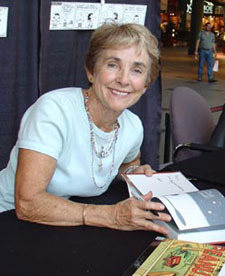 When the universe asks you if you would like to interview someone along the lines of Jean Schulz, wife of Peanuts creator Charles “Sparky” Schulz, the correct answer is somewhere along the lines of , “YES YES YES YES YES!” And so it was that by some complete quirk of fate, I found myself speaking with Ms. Schulz recently. What follows is a conversation covering everything from Sparky’s own interpretations of whether his work could be considered “art” to the recent pairing of Peanuts with ALA to the role of libraries in the world.
When the universe asks you if you would like to interview someone along the lines of Jean Schulz, wife of Peanuts creator Charles “Sparky” Schulz, the correct answer is somewhere along the lines of , “YES YES YES YES YES!” And so it was that by some complete quirk of fate, I found myself speaking with Ms. Schulz recently. What follows is a conversation covering everything from Sparky’s own interpretations of whether his work could be considered “art” to the recent pairing of Peanuts with ALA to the role of libraries in the world.
Betsy Bird: Just to recap, Peanuts, as I understand it, is pairing with ALA for library card sign-up month. At the same time Andrew McNeel the publishing company, is publishing Snoopy Cowabunga, now with a range of parenting reading tips (I think they’re even calling it Core Curriculum aligned). So what has been your role with all of this?
Jean Schulz: Actually, I haven’t had any particular role except to say, “Yes, please pursue this.” It was actually Craig Herman who worked for Peanuts, Worldwide who pursued it. We’re the board members and we said yes go ahead. We said this is terrific. I think Peanuts is perfect. Anyway it’s a perfect marriage.
BB: What is your personal take on libraries?
JS: I don’t remember going to the library as a kid because it was way out in the country. But school libraries, yes. We didn’t have computers so all of us used school libraries, all of us learned the Dewey Decimal System. The library was just part of your life when I grew up. And when I had kids in the 60s we went to the library all the time. I’ve never been on the library commission board but we live in such a small community that the library, and donating your books to the library, and going to the library booksale, being a part of that whole community of the library and its fundraising and its storytelling, has been just part of my life. I mean I don’t know if libraries are going the way of supposedly the newspapers but I don’t think so. I still see families lined up to get into the library when it opens.
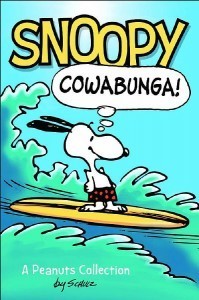 BB: So I grew up with Peanuts. My parents grew up with Peanuts. And now with Snoopy Cowabunga and the kids still reading newspaper comics we have children today growing up with Peanuts. How do you account for its longevity? What has kept it going all these years?
BB: So I grew up with Peanuts. My parents grew up with Peanuts. And now with Snoopy Cowabunga and the kids still reading newspaper comics we have children today growing up with Peanuts. How do you account for its longevity? What has kept it going all these years?
JS: I think that it deals with the real issues of life. It deals with love, it deals with sadness, it deals with bossy people, it deals with shy people, it deals with success. You know Charlie Brown is known for his failure but he never gives up. It is a small microcosm of life, and then there is Snoopy who is everybody’s alter ego. Sparky, my husband, used to say (I’ll refer to him as Sparky), “Snoopy is everything I would like to be and am not.“
BB: Ah. Like Walter Mitty.
JS: Yes. Exactly. And it really speaks to you. When you’re a child and read comic strips it’s speaking to you. You take seriously Charlie Brown’s heartache. You take seriously Sally’s dislike of school trips. You know you don’t want to go on the school trips either. But when you get older you relate to those same things in an adult way. And that is the secret of the comic strip is that it speaks to people on their own level. I don’t know how Sparky did that. That is a small miracle. That by encapsulating it with humor he could make it acceptable to all levels, probably all educations, all cultures!
BB: That’s true. I think that the great comics that came after Peanuts did similar things and followed in its footsteps, in that adults would get as much of a kick out of them as kids. They would sort of cross generational lines. It’s funny, I never thought of it that way.
Now what is your take on kids and comics? In the past comics were seen as throwaway literature. You know, no one would have given them any literary merit. But these days you know libraries and teachers and parents are embracing them. What’s your take on all that?
 JS: Well, there are two things. One is that my mother used to give comic books credit for teaching my brother to read. Kids learned to read all the time with comics. And obviously the comics in the paper come and go so fast, four seconds maybe, that by the time you put them in a book, which is what Andrews McNeel has done, you have given it a continuity. And if you don’t know a word, the pictures help you. Although I have to say in Peanuts it’s probably a little more subtle. If you read the little early readers it’ll say “She saw the dog.” Peanuts is more subtle than that, but still, the pictures are fun to look at and make you want to read the words, want to learn the words. And, of course, because now they call them graphic novels they now have an acceptability in the marketplace. Some of the people who do graphic novels don’t want them to be called “novels”. They really like the term “comics!” And they think that people calling them graphic novels is so that they can sell them in the bookstores.
JS: Well, there are two things. One is that my mother used to give comic books credit for teaching my brother to read. Kids learned to read all the time with comics. And obviously the comics in the paper come and go so fast, four seconds maybe, that by the time you put them in a book, which is what Andrews McNeel has done, you have given it a continuity. And if you don’t know a word, the pictures help you. Although I have to say in Peanuts it’s probably a little more subtle. If you read the little early readers it’ll say “She saw the dog.” Peanuts is more subtle than that, but still, the pictures are fun to look at and make you want to read the words, want to learn the words. And, of course, because now they call them graphic novels they now have an acceptability in the marketplace. Some of the people who do graphic novels don’t want them to be called “novels”. They really like the term “comics!” And they think that people calling them graphic novels is so that they can sell them in the bookstores.
BB: Well, kids never ask for graphic novels. Kids ask for comics.
JS: That’s a good point. Anyway, Sparky used to say “I am a cartoonist. That’s what I want to be, that’s what I do, it’s my profession. I don’t need to be an artist”, which of course he was because his drawings spoke to people. “And I don’t need to be a writer.” He said, “Don’t flatter me by saying” (and I’m not saying these are his exact words) “oh you’re a great writer, oh you’re a great artist. I’m a cartoonist.“ And his point was, that was sufficient because that was a time honored way of communicating with people. And you know people say the first cartoons were the ones on the walls of the caves.
BB: The original visual storytelling.
JS: Exactly.
 So you asked what is my association with libraries. My father loved reading, so when he died in 1973, (he lived in a small town in Noe Valley and he lived there all his life) his wife asked for donations to be made to the library. Somewhere I had a list of the 50 books that they had bought with the money that came in, which was really nice to know. Of course those books don’t last forever. Back in 1973 we had given the money to the library or asked that people forward their money to the library and about ten or twelve or fifteen years later, probably late 80s, I wanted to do something additional. I asked the library how they could use an endowment which would produce about maybe $2500 a year. And they said storytelling. And so with the money they hire storytellers, I think they have three or four a year, and it’s to keep the people in the library. Because, you know, moms bring their children, dads bring their children, but when they get to be about 13 maybe they don’t want necessarily to come because they associate that with being younger. They developed the storytelling program that would bring in moms and 13, 14, 15 year-olds. I haven’t been to any because Noe Valley is still an hour drive from me, but their late afternoons, early evenings, invite parents and slightly older children back into the library for adventurous stories that they can all enjoy. So libraries have always been important.
So you asked what is my association with libraries. My father loved reading, so when he died in 1973, (he lived in a small town in Noe Valley and he lived there all his life) his wife asked for donations to be made to the library. Somewhere I had a list of the 50 books that they had bought with the money that came in, which was really nice to know. Of course those books don’t last forever. Back in 1973 we had given the money to the library or asked that people forward their money to the library and about ten or twelve or fifteen years later, probably late 80s, I wanted to do something additional. I asked the library how they could use an endowment which would produce about maybe $2500 a year. And they said storytelling. And so with the money they hire storytellers, I think they have three or four a year, and it’s to keep the people in the library. Because, you know, moms bring their children, dads bring their children, but when they get to be about 13 maybe they don’t want necessarily to come because they associate that with being younger. They developed the storytelling program that would bring in moms and 13, 14, 15 year-olds. I haven’t been to any because Noe Valley is still an hour drive from me, but their late afternoons, early evenings, invite parents and slightly older children back into the library for adventurous stories that they can all enjoy. So libraries have always been important.
And when you look at the comic strips, Sparky was a storyteller. That’s what he was doing.
For the best children’s biography of Mr. Schulz of all time, please be sure to check out Sparky: The Life and Art of Charles Schulz. Many thanks to Alison Hill for arranging for the interview and to Ms. Schulz herself for taking time out of her day to speak with me.
September 29, 2013
Video Sunday: So hang, boys, hang
The exciting news this week was that I got to host a couple panels regarding Banned Books (it being the week of ‘em and all). The first was at the Brooklyn Book Festival with David Levithan, Francesca Lia Block, and Lauren Myracle. I then cannibalized my own questions and used them in this, a Google+ Hangout alongside Lauren Oliver, Lev Grossman, and Lexa Hillyer. My sole objection: You cannot see my awesome shoes.
And yes. The Google offices do have free food, copious couches, and massage rooms hither and thither.
Speaking of the Brooklyn Book Festival, I was pleased as punch to see Catherine Jinks speaking there, live and in person. She mentioned this video which, through utter and total coincidence, I’d seen on my own a couple days before. Alfred. Is. Perfect. Look at his fingernails!
And speaking of awesome book trailers . . .
And yeah. Your book trailer might be awesome. But did yours ever have a snappy theme song? I’m just so pleased that our own Gregory K. (he of Gotta Book and The Happy Accident) is debuting his middle grade this year. Spoiler Alert: It’s good.
And…. okay. So, maybe I’m a pushover. Obviously this isn’t my usual video. But I just sorta liked the feel of this little paper studio and the kiddos who help out. The narrator I can live without (would that Mimi had narrated the whole thing herself) but I like the kids and I like the product. So sue.
And for the off-topic video of the day . . . was there any question what I’d go with? This video works better when you know beforehand that the father is trying to distract his daughter from the “scary” fireworks outside.
I also like the fact that he clearly did her hair that night.
September 26, 2013
Review of the Day: The Real Boy by Anne Ursu
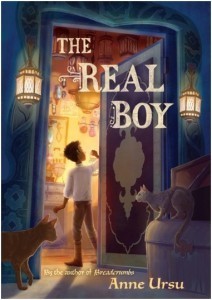 The Real Boy
The Real Boy
By Anne Ursu
Illustrated by Erin McGuire
Walden Pond Press (an imprint of Harper Collins)
$16.99
ISBN: 978-0-06-201507-5
Ages 9-12
On shelves now
My two-year-old is dealing with the concept of personhood. Lately she’s taken to proclaiming proudly “I’m a person!” when she has successfully mastered something. By the same token, failure to accomplish even the most mundane task is met with a dejected, “I’m not a person”. This notion of personhood and what it takes to either be a person or not a person reminded me a fair amount of Anne Ursu’s latest middle grade novel The Real Boy. There aren’t many children’s books that dare to delve into the notion of what it means to be a “real” person. Whole hosts of kids walk through their schools looking around, wondering why they aren’t like the others. There’s this feeling often that maybe they were made incorrectly, or that everyone else is having fun without them because they’re privy to some hitherto unknown secret. Part of what I love about Anne Ursu’s latest is that it taps directly into that fear, creating a character that must use his wits to defeat not only the foes that beset him physically, but the ones in his own head that make even casual interactions a difficulty.
Oscar should be very grateful. It’s not every orphan who gets selected to aid a magician as talented as Master Caleb. For years Oscar has ground herbs for Caleb, studiously avoiding the customers that come for his charms, as well as Caleb’s nasty apprentice Wolf. Oscar is the kind of kid who’d rather pore over his master’s old books rather than deal with the frightening conversations a day in his master’s shop might entail. All that changes the day Wolf meets with an accident and Caleb starts leaving the shop more and more. A creature has been spotted causing awful havoc and the local magic workers should be the ones to take care of the problem. So why aren’t they? When Oscar is saved from the role of customer service by an apprentice named Callie, the two strike up an unlikely friendship and seek to find not just the source of the disturbance but also the reason why some of the rich children in the nearby city have been struck by the strangest of diseases.
Though Ms. Ursu has been around for years, only recently have her books been attracting serious critical buzz. I was particularly drawn to her novel retelling of Hans Christian Andersen’s “The Snow Queen” last year in the form of the middle grade novel Breadcrumbs. So naturally, when I read the plot description and title of The Real Boy I assumed that the story would be some kind of retelling of the “Pinocchio” tale. As it turns out, there is the faintest whiff of Pinocchio circling this story, but it is by no means a strict model. As one of the librarians in my system put it, “I am scarred for life by Pinocchio (absolutely abhor any tale relating to inanimate objects longing to become real to the point where I find it creepy) but did not find this disturbing in the least.” Truth be told it would have been easy enough for Ursu to crank up the creepy factor if she had wanted to. But rather than clutter the text up with unnecessary disgust, the story is instead clean, fast, exciting, and to the point. And for all that it is 352 pages or so, you couldn’t cut it down.
There have been a fair number of novels and books for children this year that have been accused of being written with adults rather than children in mind. I’ve fielded concerns about everything from Bob Graham’s The Silver Button to Cynthia Rylant’s God Got a Dog to Sharon Creech’s The Boy on the Porch. Interestingly, folks have not lobbed the same criticisms at The Real Boy, for which I am grateful. Certainly it would be easy to see the title in that light. Much of the storyline hinges on the power of parental fear, the sometimes horrific lengths those same parents will go to to “protect” their young, and the people who prey on those fears. Parents, teachers, and librarians that read this book will immediately recognize the villainy at work here, but kids will perceive it on an entirely different level. While the adults gnash their teeth at the bad guy’s actions, children will understand that the biggest villain in this book isn’t a person, but Oscar’s own perceptions of himself. To defeat the big bad, our hero has to delve deep down into his own self and past, make a couple incorrect assumptions, and come out stronger in the end.
He is helped in no small part by Callie. I feel bad that when in trying to define a book I feel myself falling back on what it doesn’t do rather than what it does do. Still, I think it worth noting that in the case of Callie she isn’t some deux ex machina who solves all of Oscar’s problems for him. She helps him, certainly. Even gets angry and impatient with him on occasion, but she’s a real person with a personal journey of her own. She isn’t just slapped into the narrative to give our hero a necessary foil. The same could be said of the baker, a fatherly figure who runs the risk of becoming that wise adult character that steps in when the child characters are flailing about. Ursu almost makes a pointed refusal to go to him for help, though. It’s as if he’s just there to show that not all adults in the world are completely off their rockers. Just most, it would seem.
There’s one more thing the book doesn’t do that really won my admiration, but I think that by even mentioning it here I’m giving away an essential plot point. Consider this your official spoiler alert, then. If you have any desire to read this book on your own, please do yourself a favor and skip this paragraph. All gone? Good. Now a pet peeve of mine that I see from time to time and think an awfully bad idea is when a character appears to be on the autism spectrum of some sort, and then a magical reason for that outsider status comes up. One such fantasy I read long ago, the autistic child turned out to be a fairy changeling, which explained why she was unable to communicate with other people. While well intentioned, I think this kind of plot device misses the point. Now one could make the case for Oscar as someone who is on “the spectrum”. However, the advantage of having such a character in a fantasy setting is that there’s no real way to define his status. Then, late in the book, Oscar stumbles upon a discovery that gives him a definite impression that he is not a human like the people around him. Ursu’s very definite choice to then rescind that possibility hammered home for me the essential theme of the book. There are no easy choices within these pages. Just very real souls trying their best to live the lives they want, free from impediments inside or outside their very own selves.
I’ve heard a smattering of objections to the book at this point that are probably worth looking into. One librarian of my acquaintance expressed some concern about Ursu’s world building. She said that for all that she plumbs the depths of character and narrative with an admirable and enviable skill, they never really felt that they could “see” the world that she had conjured. I suspect that some of this difficulty might have come from the fact that the librarian read an advanced reader’s copy of the book without the benefit of the map of Aletheia in the front. But maybe their problem was bigger than simple geography. Insofar as Ms. Ursu does indulge in world building, it’s a world within set, tight parameters. The country is an island with a protected glittering city on the one hand and a rough rural village on the other. Much like a stage play, Ursu’s storyline is constricted within the rules she’s set for herself. For readers who prefer the wide all-encompassing lands you’d see in a Tolkien or Rowling title, the limitations might feel restrictive.
Now let us not, in the midst of all this talky talk, downplay the importance of illustrator Erin McGuire. McGuire and Ursu were actually paired together once before on the underappreciated Breadcrumbs. I had originally read the book in a form without the art, and it was pleasant in and of itself. McGuire’s interstitial illustrations, however, really serve to heighten the reader’s enjoyment. The pictures are actually relatively rare, their occasional appearances feeling like nothing so much as a delicious chocolate chip popping up in a sea of vanilla ice cream. You never know when you’ll find one, but it’s always sweet when you do.
Breadcrumbs, for all that I personally loved it, was a difficult book for a lot of folks to swallow. In it, Ursu managed to synthesize the soul-crushing loneliness of Hans Christian Andersen’s tales, and the results proved too dark for some readers. With The Real Boy the source material, if you can even call it that, is incidental. As with all good fantasies for kids there’s also a fair amount of darkness here, but it’s far less heavy and there’s also an introspective undercurrent that by some miracle actually appears to be interesting to kids. Whodathunkit? Wholly unexpected with plot twists and turns you won’t see coming, no matter how hard you squint, Ursu’s is a book worth nabbing for your own sweet self. Grab that puppy up.
Source: Galley sent from publisher for review.
Like This? Then Try:
Changeling by Delia Sherman
Jinx by Sage Blackwood
The Mostly True Story of Jack by Kelly Barnhill
September 24, 2013
Press Release Fun: KidLitCon 2013 is Nigh!!
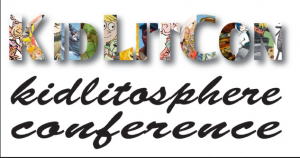 As some of you might remember, last year I hosted the Kidlitosphere Conference (or KidLitCon) in the main branch of NYPL. There were publisher previews. There were amazing speakers and talks and rooms. Grace Lin did our Friday night dinner keynote and Maureen Johnson closed out the conference with the final keynote. In all, it was a rousing success. Nobody died. I consider that a win. You can read my full recap of the experience (barring the sheer hell I went through with the bloody programs) here.
As some of you might remember, last year I hosted the Kidlitosphere Conference (or KidLitCon) in the main branch of NYPL. There were publisher previews. There were amazing speakers and talks and rooms. Grace Lin did our Friday night dinner keynote and Maureen Johnson closed out the conference with the final keynote. In all, it was a rousing success. Nobody died. I consider that a win. You can read my full recap of the experience (barring the sheer hell I went through with the bloody programs) here.
Well now the time has come to do it all again . . . in Texas. Yes, I’m not hosting this one, partly because I’ve developed this real love affair with sanity. Sanity is my friend. I’m keen on it. Traditionally this conference tends to move about so that folks from all over the country can attend. So if you were bummed at our Eastern location in 2012, check out the following and register early!
Kidlitosphere Conference 2013
The seventh annual KidLitCon on November 9th in Austin, Texas is officially accepting registrations!
While we would love to be ahead of schedule with well, a schedule, we invite you to register now to help your organizers plan for attendance. Registering early will also give you a chance to suggest topics that YOU would like to see at KidLitCon 2013. Register before October 11th for $10 off the registration fee and a chance to win a prize package of books and goodies!
Once you register, you will receive a confirmation email with instructions for sending your check or money order. Hotel information will also be available, hopefully with a discount for our group.
We are still accepting proposals for workshops and panel discussions. Past KidLitCon sessions have included topics such as ethics of reviewing, diversity in children/teen literature, effective marketing, kidlit social media, and online community building. If you are interested in presenting at KidLitCon, please submit a proposal soon.
Look to this website for updates to the schedule, including our Friday evening event.
Lots more info to come. For now, start spreading the word! Be a fan on Facebook! Follow us on Twitter! And best of all register to attend KidLitCon 2013.



